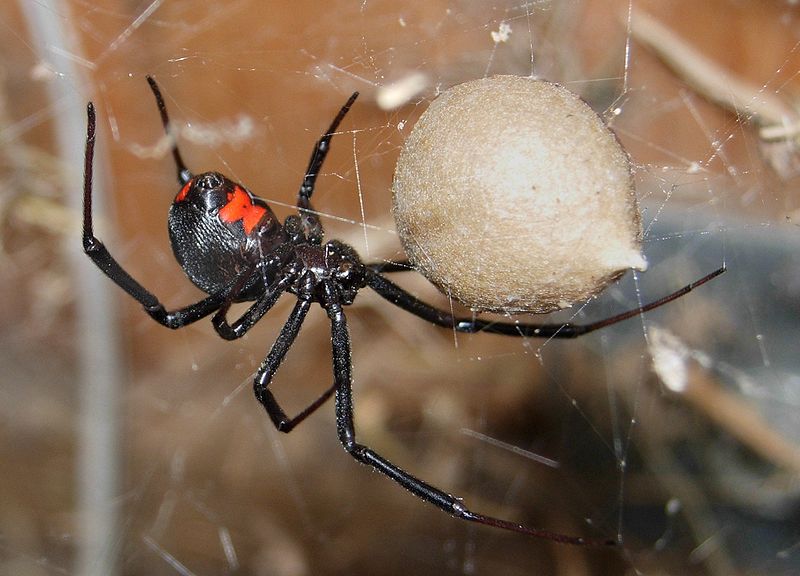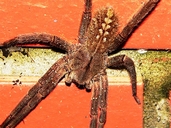According to New Mexico State University, the southwestern state of New Mexico is home to more than 1,000 spider species. While every spider is capable of biting and injecting venom, most of them are harmless. Their fangs are too small and their venom is too limited to cause more than swelling, irritation, and itching. However, there are two genera of spiders in New Mexico that are considered dangerous.
Widow Spiders (Latrodectus)
Two species of widow spiders are found in New Mexico, according to Venombyte.com. Only female widows are considered dangerous. The western black widow (Latrodectus hesperus) is glossy black, adorned with a red hourglass shape on the underside of its abdomen. The brown widow (Latrodectus geometricus) varies from cream to dark brown and is adorned with an orange or yellow hourglass. Widows are not aggressive but will bite if handled or threatened, especially if an egg sac is present. They typically build their webs in areas that sit undisturbed for periods of time, like sheds, dormant lawn equipment, patio furniture, garages, basements, crawl spaces, and under decks.
Recluse Spiders (Loxosceles)
Five species of recluse spiders have been found in New Mexico. The Apache (Loxosceles apachea), Arizona (Loxosceles arizonica), desert (Loxosceles deserta), and blanda or Big Bend (Loxosceles blanda) are long-established residents. The brown recluse (Latrodectus reclusa) is newly reported in the city of Roswell, according to New Mexico State University. Recluse spiders are often called violin or fiddleback spiders because of the violin-shaped mark on their backs, although not every recluse spider has this defining characteristic. They vary in color from yellow-tan to brown, and possess six eyes arranged in three pairs of two. They typically live under dead cacti, logs, rocks, or other debris.
The Venom
Widow spiders inject a neurotoxin that travels through the bloodstream and attacks the nervous system. Varying degrees of pain occur, eventually localizing in the abdomen and back. Symptoms include cramping, nausea, fever, perspiration, tremors, restlessness, elevated blood pressure, and respiratory distress. Death occurs in 5 percent of all widow bite cases. The venom of recluse spiders contains necrotizing enzymes. The bite site immediately swells and hardens. If left untreated, the bite will progress to a painful, ulcerated wound that can take months to heal. Recluse venom can cause organ damage and even death, but this is very rare. If a widow or recluse bite is suspected, medical attention should be sought immediately, and if at all possible, the offending spider or its remains should be brought in for testing.
Prevention
The New Mexico Poison and Drug Information Center recommend you be proactive in the prevention of spider bites. Dust and vacuum your home regularly, especially in corners, crevices, around windows, and under furniture. Keep the inside and outside of your home clear of clutter and debris, and never stack wood close to your house. Wear gloves when you work outdoors, particularly when handling rocks, woodpiles, brush and dormant lawn equipment. Have your home and yard professionally treated for poisonous spiders — just make sure the pesticide is safe for children and pets.
Spiders
The venom of two spiders in New Mexico can cause serious illness: the black widow and the brown spider. Read below to find out more about these spiders.

Black Widow Spider
Black Widow spiders have a shiny black color and large, rounded abdomens. Females are larger than males, ranging from one to two inches in diameter. The female also differs from the male in that she has a red marking on her abdomen that may or may not look like an hourglass; however, it is not recommended that one handles the spider to try to identify the hourglass shape.
The bite is most painful for 8 to 12 hours after being bitten. Black Widow venom causes severe muscle spasms all over the body and can be deadly, especially in small children.

Apache Brown Spider
In New Mexico, there are three species of brown spiders: the blanda, desert, and Apache. All three species are similar-looking spanning about an inch in length including the legs and light to dark brown in color. As close relatives to the brown recluse, the brown spiders may or may not have the “violin” marking present on their bodies.
All three species live outdoors under logs, rocks, dead cacti, in burrows, etc. Their venom is very potent and can be deadly, especially in small children.
Prevention and First Aid Tips
- Dust and vacuum around windows, corners of rooms, and under furniture regularly.
- Wear gloves when working with woodpiles, brush, and rocks; avoid stacking wood against your home.
- Shake shoes before wearing them.
- Have a professional exterminate for poisonous spiders on a regular basis; request a pesticide that is safe for children and pets.
- If you think that you have been bitten by a spider that can cause serious illness, call the New Mexico Poison Center right away for treatment advice: 1-800-222-1222.





